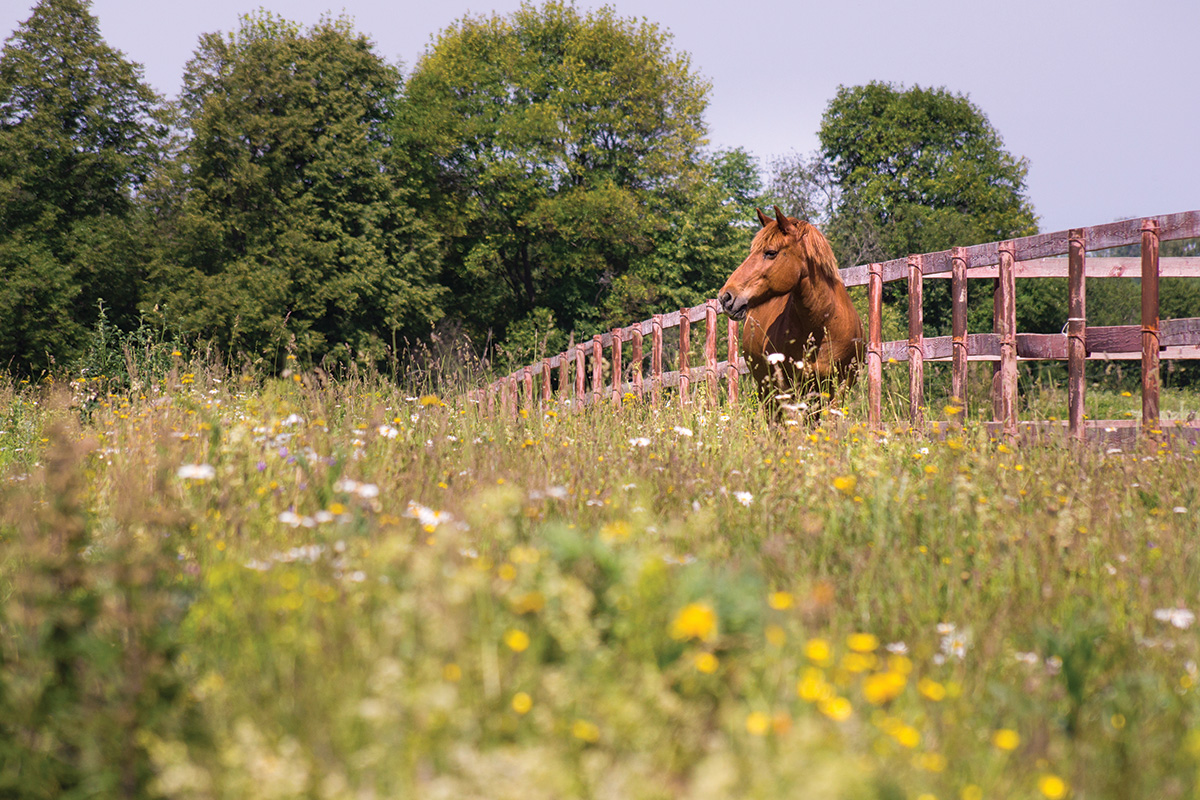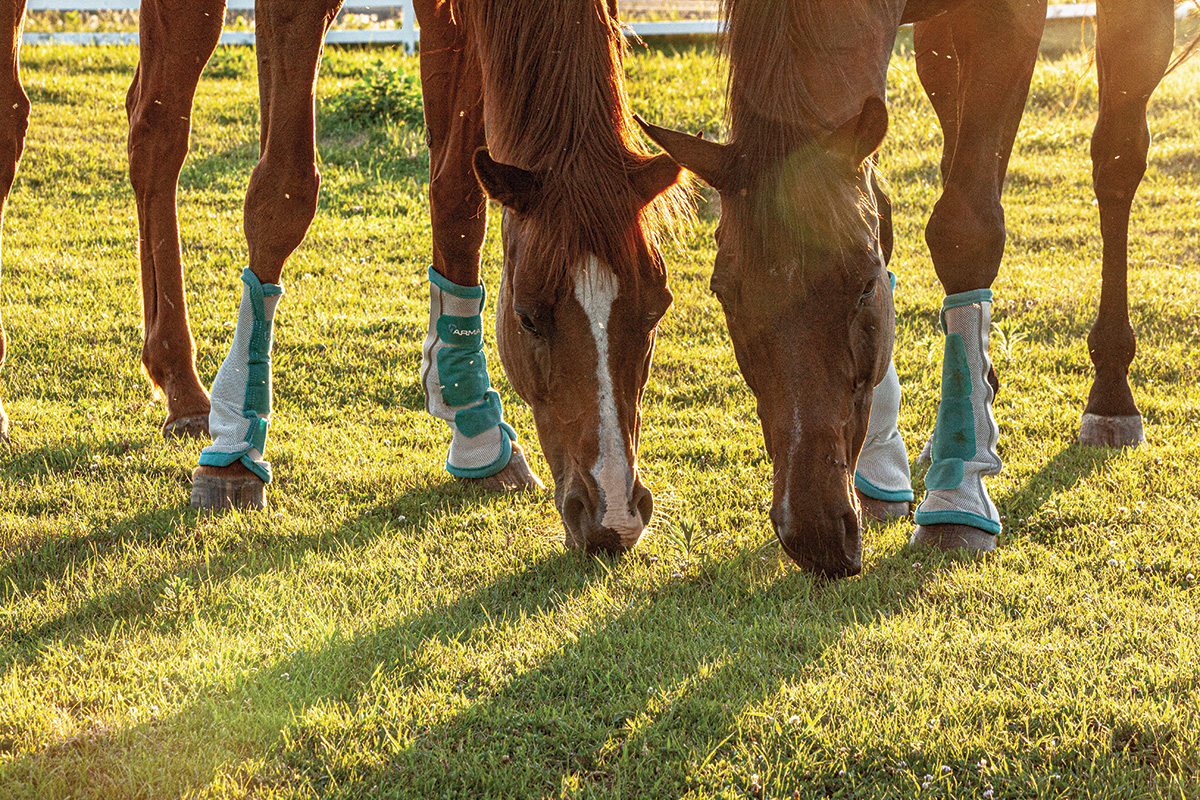
While many experts agree that fleas are an uncommon parasite for horses, ticks can be prevalent and potentially present a danger to your horse’s health.
Protect your equine by watching for signs of flea or tick problems and treating issues right away or preventing them altogether.

How Common Are Tick Infestations with Horses?
“Horses aren’t the preferred hosts for fleas like dogs, cats and foxes are,” says Laura Stern, DVM, DABVT, director of training and quality assurance for the ASPCA Animal Poison Control Center. “The reason horses aren’t commonly affected by fleas, but do get ticks, is simple: They’re in places where they commonly encounter ticks, but not fleas. Fleas like dark areas, like dens. Those aren’t the places where horses like to be. However, ticks like long grass and wooded areas—places where horses are commonly found—making them a common target for ticks.”
“Fleas don’t like horses,” agrees Garrett Metcalf, DVM, DACVS-LA, an equine veterinarian at Pine Ridge Equine Hospital in Glenpool, Okla. “Fleas are species-specific, and horses aren’t a suitable host for fleas, so it’s rare to have fleas on horses. Ticks are a common problem and rather good at transmitting diseases to horses.”
Signs of a Tick Problem with Your Horse
Horse owners are very protective of their animals, and typically attuned to changes in their behavior. However, a tick’s small size makes it easier for them to hide, so it’s essential to be aware of signs you might blame on something else that could indicate a tick issue.
The first step is to stay alert and physically look for ticks on your horse’s body while being aware of any potentially serious side effects of a tick bite. Besides the actual tick body, Stern says to look for a raised, hard bump where a tick was feeding. She says you might see your horse rubbing a particular spot where a tick is or was, and experience hair loss due to excessive rubbing.
“If your horse has a severe tick infestation or if he seems weak, wobbly or has pale gums, contact your veterinarian immediately before trying to remove any ticks, as you may cause damage to the skin or stress the horse in his weakened condition,” she cautions.
Metcalf advises looking around the groin, head, and region under the tail where ticks often like to accumulate. He says that you might notice swelling in areas where ticks have bitten a horse and edema around the bite site.
“If a horse is head-shy while haltering, lethargic, or has a fever, and ticks are present on the horse, it would be best to have the horse examined by a veterinarian,” he says. “Ticks are a common [cause of] swelling and pain around the ears, and most tick-borne diseases will cause fever and lethargy as the main clinical signs.”
Health Hazards of Infestation
Ticks infected with serious diseases don’t usually transmit those pathogens immediately. Instead, they usually must feed on the host—namely your horse—for a while before disease transmission occurs. This delay in disease transition makes it extremely important to remove ticks as soon as possible.
While less critical issues such as itchiness, hair loss, poor hair coat and local irritation can occur, Stern stresses that more serious problems such as infection at the site of tick attachment, anemia from blood loss in severe cases, and tick-transmitted disease could occur.
“Ticks can transmit a number of diseases to horses, including Lyme disease, equine granulocytic anaplasmosis and equine piroplasmosis,” says Stern. “Rarely, we may also see tick paralysis. There’s typically a delay of 24 hours between when the ticks attach and when they can transmit diseases, which makes it very important to find them quickly and remove them before they have the chance to transmit any diseases.”
An Ounce of Prevention
Prevention is always preferable to treatment, which is true of fleas and ticks. If you can keep your stable and pasture free of these parasites, you avoid having to remove ticks from your horse and could prevent potentially serious problems.

Metcalf suggests using permethrin-based products, which he says are the best store-bought products to combat fleas or ticks on horses.
“It’s rather difficult to prevent ticks from getting onto horses,” he cautions. “Concentrated, topically applied permethrin products may be the best option at this time. Some of these products need to be applied every three weeks.
“Natural remedies aren’t very effective against reducing ticks on horses,” he continues. “Some essential oil recipes use geranium oil as a possible tick repellent. Physical barriers, such as fly boots, may help reduce ticks from getting onto the limbs of horses.”
Stern also touts various tick repellents and products that kill ticks. She says there are some sprays you can use before a ride and topical spot-on products that work longer for horses more consistently at risk of encountering ticks.
“You can use a repellent to help keep ticks off your horses,” says Stern. “Repellents often contain a pyrethroid insecticide, such as permethrin or cypermethrin. Repellents have the advantage of not requiring the ticks to bite and take a blood meal. Avermectins, such as moxidectin and ivermectin, can also kill ticks, but [the ticks] need to take a blood meal first.”
She cautions the importance of always reading the label of any flea and tick product you use to ensure it’s appropriate for use on horses.
“Some cattle products can cause significant toxicity in horses,” warns Stern. “[And] some products won’t be labeled for use on certain horses, especially foals under 3 months of age. Always apply per the labeled [instructions] to minimize the risk of side effects, as well. Your veterinarian can help you determine what product will be best, based on the risk of exposure to ticks, the risk of ticks carrying disease, and your horse’s lifestyle and health history.”
Other Remedies
Besides treating your horse, you should always pay attention to his surroundings. Stern says ticks are generally more of an issue outside of barns, so you don’t typically need tick control inside your barn.
“If fleas are present in the barn, it’s generally not an issue for horses,” she says. “But you can minimize risk by preventing wildlife from entering the barn and ensuring that cats and dogs who have access to the barn are treated with flea preventatives. Treating the environment may be needed for heavy flea infestations.”
One of the best all-natural ways of minimizing tick exposure is to keep horses out of areas that contain a lot of ticks. Of course, that isn’t always possible.
“Ticks are often found in tall grasses and wooded areas,” says Stern. “They dislike hot, sunny areas with no plant cover. An easy way to minimize the number of ticks your horses are exposed to is by mowing any tall grass, removing weeds, and preventing your horse from entering wooded areas or hanging around the boundaries between woods and pasture. Preventing wildlife, especially deer, from entering pastured areas is another important step you can take to decrease the number of ticks in your pasture.”

Metcalf also suggests using pasture insecticides to help reduce fleas or ticks in your pasture. He cautions that whenever a heavy amount of wildlife traffic is present, there’s more of a reservoir of future ticks or fleas to re-establish residency in the pasture.
Tick Removal Tips
Any time you’ve been out riding—or at least once a day if your horse is on pasture—you should check him for ticks. A visual inspection is an excellent first step, but using your fingers to feel around for small ticks that might not be easy to see is also important.
“Deer ticks that transmit Lyme disease only reach 3mm when fully grown and can be hard to see,” says Stern. “The most important areas to check your horse for ticks are the chest, belly, flanks, mane, tail and ears—places where the skin is thinner and ticks can more easily attach.”

Even if you take precautions such as using tick repellents and keeping your horse out of areas ticks might frequently hang out, your horse will inevitably pick up a tick or several during tick season. Stern cautions that there are a lot of myths about the best way to remove a tick from a horse.
“You don’t want to crush the tick, use a hot match, or apply something like baby oil to try to smother it,” she says. “Instead, put on a pair of gloves and take tweezers and grasp the head of the tick close to the site of attachment to the horse. Then, slowly pull the tick away at a 90-degree angle from the horse. This will allow you to remove the entire tick.
“After you remove the tick, wash the skin in the area where the tick was attached with a mild soap and then wash your hands,” Stern continues. “Ticks should be placed in a jar of isopropyl alcohol, which can be disposed of when full. If you notice that the head of the tick wasn’t removed from the horse, contact your veterinarian, as the site can become infected.”

Metcalf agrees that physically removing ticks from horses with your fingers or a hemostat-like instrument is a safe removal method. However, he says some owners might want to kill the ticks first with a permethrin spray, then use physical removal methods.
“Your veterinarian is your best source of information about preventing or controlling ticks,” adds Stern. “They have knowledge of which products work best in your area and the best control strategy, given your horses and your facility. Having preventative measures in place before you have an issue is best. Scheduling a visit with your vet in the late winter or spring is an ideal time to get a holistic tick-control program set up for your horses, but it’s never too late in the year to reach out and get an expert opinion from your vet.”
Ticks and Horses: Key Takeaway
Because ticks can transmit serious diseases, it’s crucial for horse owners to stay vigilant by regularly checking their horses for ticks and taking preventive measures to reduce exposure. By staying informed and taking action early, you can minimize the risk of tick infestations and ensure your horse remains healthy and comfortable.
This article about ticks with horses appeared in the September 2023 issue of Horse Illustrated magazine. Click here to subscribe!






